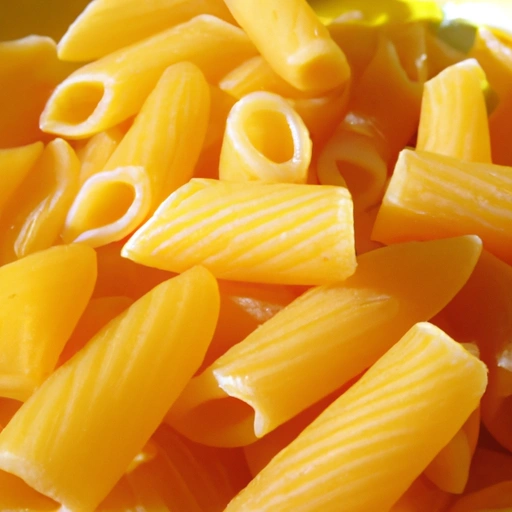Penne
Description

Penne is a type of pasta with cylinder-shaped pieces that have angled ends, resembling the nib of an old feather quill or pen, hence the name 'penne.' It is a versatile pasta that holds sauce well due to its ridges and hollow center. Measuring around 1.25 to 1.5 inches (3.17 to 3.81 cm) in length, penne pasta is a popular choice in a variety of dishes, ranging from pasta salads to baked casseroles. Penne is traditionally made from durum wheat semolina, but it also comes in whole wheat and gluten-free varieties to suit different dietary needs.
Common uses
Penne is commonly used in pasta dishes served with tomato-based, cream-based, or oil-based sauces. It is also ideal for baking in casseroles, adding to soups, or mixing into salads. The pasta's versatility and ability to pair well with a variety of ingredients make it a go-to choice for cooks around the world.
Nutritional value
Calories
A typical serving of cooked penne pasta (2 ounces or 56 grams dry) provides approximately 200 calories.
Protein
This serving size contains roughly 7 grams of protein, contributing to muscle growth and repair.
Fat
Penne pasta is low in fat, with only 1 gram per serving, making it a heart-healthy option.
Carbohydrates
It is rich in carbohydrates, providing about 42 grams per serving, which is essential for energy.
Vitamins
While not a significant source of vitamins, enriched penne pasta may contain added B vitamins.
Minerals
Penne provides minerals such as iron and magnesium, the amounts of which may vary based on the flour used.
Health benefits
Penne pasta, particularly whole wheat varieties, can be part of a balanced diet. It offers energy-providing carbohydrates and is a source of fiber, which aids in digestion and can help in maintaining a healthy weight. Additionally, pasta's low-fat content supports heart health.
Potential risks
Overconsumption of pasta, like any high-carbohydrate food, can lead to weight gain. Those with gluten sensitivity or celiac disease should avoid traditional penne made from wheat and opt for gluten-free alternatives.
Common recipes
Penne is featured in numerous recipes, including Penne alla Vodka, Penne Arrabbiata, and baked Ziti. It is also used in pasta salads and dishes that require the pasta to be baked with cheese and sauce.
Cooking methods
Penne should be boiled in salted water until 'al dente,' which is typically 9 to 13 minutes. It can also be baked or sautéed with other ingredients.
Pairing with other ingredients
This pasta pairs well with hearty meat sauces, vegetables, cheese, and various herbs and spices, making it suitable for a wide range of dishes.
Summary
Penne pasta is a beloved and adaptable ingredient that has made its way into the hearts and kitchens of food enthusiasts across the globe. Its practical design and compatibility with numerous sauces and cooking techniques make it a staple in many culinary traditions. When enjoyed in moderation and prepared with nutritious accompaniments, penne can be part of a healthy and satisfying diet.